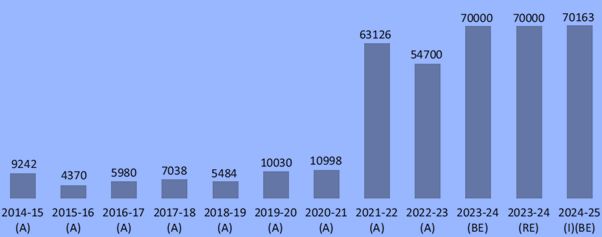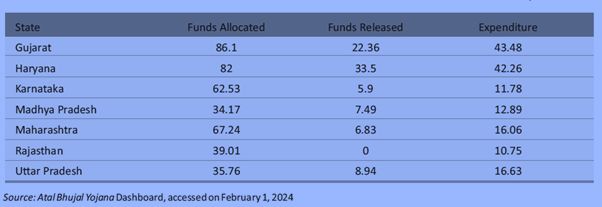
The Ministry of Jal Shakti (MoJS), which has been entrusted with the pivotal role of overseeing the development and management of India's water resources, serves as the bedrock for the Water, Sanitation, and Hygiene (WASH) sector, through flagship initiatives such as the Jal Jeevan Mission (JJM) and the Swachh Bharat Mission (SBM).
Within this framework, the Department of Drinking Water and Sanitation (DoDWS) and the Ministry of Housing and Urban Affairs (MoHUA) have advanced the agenda of extending access to safe drinking water and enhancing sanitation infrastructure in both rural and urban communities substantially, across the nation.
An analysis of budgetary allocations reveals a steady upward trajectory in funding for the DoDWS, accounting for 1.62 per cent of the total budget, which aligns broadly with the established trend observed over the last five years. This consistency underscores the ongoing challenge of scaling financial commitments to match the growing demands of the WASH sector, where the allocation for water and sanitation as a proportion of the Gross Domestic Product (GDP) has remained relatively unchanged. It remains to be seen if this trend will continue, even after the even after the targets for JJM are achieved within the stipulated time frame.
Figure: Allocations for the DoDWS (Rs crore) as a proportion of total Union Budget and GDP

Source: Compiled by CBGA from Union Budget documents, various years.
Access to clean water: Continued budgetary commitment to Jal Jeevan Mission
In a span of four years since its inception in 2019, the JJM has embarked on an ambitious journey to ensure functional household tap connections (FHTCs) for every rural household, embodying the mission of 'Har Ghar Jal'—water for every home. The concept of FHTC under JJM not only seeks to bridge the gap in access to potable water in India's rural areas but also emphasises the critical aspects of water quality and the sustainability of water sources. As per the latest MIS report of the DoDWS, the coverage of FHTCs increased from 323.62 lakh in August 2019 to 1,396.98 lakh as of December 2023.
The achievement of 100 per cent coverage in Goa, Gujarat, Haryana, Himachal Pradesh, Punjab, Telangana and Union Territories, including Dadra and Nagar Haveli, Puducherry, and the Andaman & Nicobar Islands, is the highlight in this regard. Conversely, states such as Jharkhand, Rajasthan and West Bengal have reported lower coverage rates, with national coverage standing at 72.5 percent.
Significantly, this marks an increase of 67 per cent in rural households with tap water connections since JJM's launch, suggesting that nearly 13.97 crore households nationwide are now enjoying the convenience of on-premises tap water access.
Reflecting its ongoing priority, the JJM has once again secured a modest allocation in the interim budget for 2024–25, albeit with a marginal increase. The decade-long trend underscores a substantial budgetary escalation (335 per cent) in the fiscal year 2021–22, sustaining a heightened level of investment that underscores the mission's progress towards achieving universal tap-water connectivity. While the majority of the investments have been directed towards building infrastructure for household piped-water supply, the crucial issue is how current and future funding will ensure continuous access, availability, and safety of the promised amount of piped drinking water.
Figure: Union Government Expenditure on Jal Jeevan Mission (Rs. crore)

Source: Compiled by CBGA from Union Budget documents, various years.
As observed by the Standing Committee Report on Water Resources 2022–23, there has been underutilisation of funds allocated to the JJM, which highlights a significant discrepancy between budget estimates, revised estimates, actual expenditure, and the physical performance of the initiative. This issue is further complicated by state-wise variations in fund utilisation, which can be attributed to differing infrastructural and institutional capabilities across regions. Addressing these gaps is critical to ensuring that the substantial investments in the drinking water sector translate into tangible improvements in access to clean water and sanitation facilities nationwide, particularly for the neediest populations.
Beyond tap connections: Integrating sustainability and community participation in the Jal Jeevan Mission and Atal Bhujal Yojana
The JJM, crucial for achieving UN Sustainable Development Goal 6, extends beyond providing household tap connections to focus on groundwater reliance, emphasising water quality and management. Its scope is broadened to encompass not only the provision of tap water connections but also the sustainable management of water resources, particularly in regions facing water scarcity, wherein integration with schemes such as Atal Bhujal Yojana becomes vital.
Addressing these concerns involves a comprehensive strategy encompassing the integration of data for water usage management, metering of water consumption, addressing the debate on pricing for usage beyond entitled limits, and empowering local stakeholders through capacity building and social mobilisation for sustainable water resource management.
The engagement of Village Water and Sanitation Committees (VWSCs) and community resource persons, such as taking into account the Anurakshaks in Bihar, the Surakshas in Maharashtra, water volunteers in Meghalaya, and Jal Sahiyas in Jharkhand, exemplifies effective community participation in water management.
As mentioned, the Atal Bhujal Yojana (ABY), an initiative under the Ministry of Jal Shakti, emerges as a complementary scheme aimed at enhancing groundwater management and security. With an initial outlay of Rs 6,000 crore upon its launch in 2020, ABY focuses on improving groundwater management through a combination of supply and demand interventions, particularly in water-stressed regions of the country, covering 7 states. Despite its ambitious goals, budgetary allocations for ABY have gone down significantly over years, with Rs 1,778 crore allocated for 2024-25 (I)(BE), mirroring the revised estimate from the previous year exactly.
The State-wise variations in fund distribution, release, and expenditure are also reflective of the institutional constraints around the financial processes at all levels (Table below). This underscores the need for a nuanced approach to address the complex challenges of water and groundwater source management across diverse geographic and socio-economic landscapes, indicating the need for a much higher allocation (to have nationwide coverage) and strengthened technical, administrative, and financial capacities.
Table: Fund Allocation, Release and Expenditure on Atal Bhujal Yojana (in Rs Crore)

Efficient monitoring of water supply necessitates precise measurement and robust data. The absence of detailed information regarding water availability and quality presents significant challenges for water utilities. Data derived from the eJalShakti dashboard reveal an average water supply exceeding 250 litres per capita per day (LPCD), a figure that is quintuple the JJM programme's recommended standard of 55 LPCD. This imbalance not only underscores the critical need for rigorous data collection and analysis, but also brings to light concerns surrounding the management and protection of water as a precious resource, including metering and tariffing of water.
The issue of water tariffs to reduce overuse or wastage of this precious resource has emerged as a pivotal factor in its effective management, suggesting a need for a nuanced approach to ensure sustainability. Additionally, the Standing Committee on Water Resources (2022) has shed light on the practice of providing subsidies for electricity and fertilisers, which incentivises farmers to cultivate water-intensive crops, even in regions grappling with water scarcity. This practice is a potential area for policy attention and careful intervention. Such measures should not only contribute to more sustainable water use but also align with broader environmental conservation efforts, highlighting the intricate connections between agricultural practices, water management, and sustainable development, as well as finding alternatives to meet the needs of farmers.
Advancing sanitation and hygiene: The situation and challenges of the Swachh Bharat Mission
Launched in 2014, the Swachh Bharat Mission (SBM) has evolved into its second phase, SBM 2.0, initiated in 2020. Dedicated to maintaining Open Defecation Free (ODF) status and expanding into solid and liquid waste management, this phase requires a substantial budget for sustained success. The SBM dashboard indicates the need for financial investment in infrastructure and community toilets.
Despite a 54% increase in funding for SBM-Urban in the 2023–24 budget, the current year's allocation remains unchanged. This static funding, especially during SBM Phase II's focus on Solid and Liquid Waste Management (SLWM), contrasts with a 50% reduction in funding for SBM-Gramin between 2016–17 and 2022–23. Actual spending consistently falls short of budgeted estimates since 2018–19, revealing a gap between planned commitments and execution.
The lack of a budget increase may indicate a potential de-prioritisation of implementation. SBM II's ambitious goals, spanning urban and rural settings, necessitate a higher budget allocation. Despite suggestions for gap funding, especially in Scheduled areas, functional challenges persist, emphasising the need for realigned funding strategies. The budget was expected to address financial gaps in providing sanitation facilities at individual and household levels, as identified by government agency studies and surveys. In summary, adequate financial support is crucial to achieving SBM Phase II's critical waste management objectives and addressing sanitation needs at various levels.
Figure: Budgetary Allocation/Expenditure for Swachh Bharat Mission (Rural & Urban) (Rs. crore)

Source: Compiled by CBGA from Union Budget documents, various years.
The SBM consistently experiences variations between initial budget estimates and subsequent allocations, highlighting the urgency for improved planning and forecasting. Persistent underutilisation of allocated funds underscores the need for refined operational strategies. A comprehensive review and adjustment of planning and execution processes are essential to bridge the gap between budgeted intentions and realisation, optimising the impact of SBM towards sanitation and hygiene goals.
Figure: SBM (Rural): Actuals vs Budget Estimates

Note: *For the year 2023–24, the revised estimate (RE) has been taken into consideration.
Source: Compiled by CBGA from Union Budget documents, various years.
The implementation of SBM Phase II faces multifaceted challenges hindering its effectiveness. A primary issue is the insufficient awareness within the user community, coupled with inadequate training for local implementing bodies, undermining the mission's efficiency. Despite the 15th Finance Commission's recommendations, the synergy between departments remains suboptimal, impeding the balanced fund allocation between water and sanitation initiatives.
Deep-seated cultural barriers, especially those surrounding menstrual hygiene and toilet usage, obstruct behavioural change and sanitation practices' acceptance. Overcoming these hurdles demands not only infrastructure development but sustained community engagement, emphasising menstrual hygiene. The pandemic has underscored the neglect of other hygiene aspects, such as hand hygiene, in budget processes.
Geographical challenges, notably in hilly and remote areas, complicate consistent water supply, which is crucial for maintaining sanitation standards. Urban contexts witness disparities in sanitation coverage, with the urban poor disproportionately affected by inadequate services. The contrast between formal settlements and informal slum areas exacerbates challenges in urban planning, infrastructure development, and service delivery.
SBM-R Phase II encounters obstacles in implementing Solid and Liquid Waste Management interventions, with capacity building and inter-departmental coordination issues. Despite a budget increase for 2024-25, the gap between initial estimates and revised figures is notable. The discontinuation of funding for the SRMS poses a setback for rehabilitating sanitation workers. Despite the poor implementation of the scheme, its presence was vital in supporting one of the country's most vulnerable communities. This contrasts with initiatives such as Odisha's Garima Scheme, which effectively categorised core sanitation tasks as highly skilled professional work, leading to skill enhancement and wage improvement for workers.
A unified WASH strategy and financing are imperative for the success of SBM Phase II. Emphasising geographical inclusivity in the 2024–25 budget speech, the finance minister highlights the need for substantial investments in water management infrastructure, community training, and water treatment facilities. Overcoming challenges requires enhancing capabilities, fostering collaboration, addressing cultural sensitivity, and empowering local communities and governments. Achieving sustainable water management, improved sanitation, and hygiene in India hinges on these concerted efforts.
The full report by CBGA is available here
/articles/indias-wash-allocations-initiatives-gaps-and-future-strategies-budget-2024-25